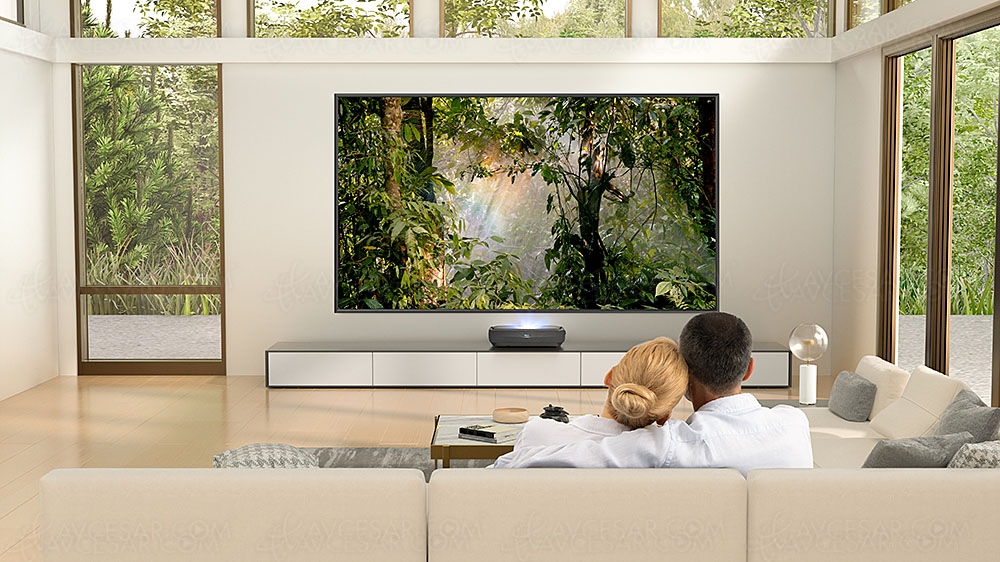The Chinese television manufacturer sees the future big, very big, on very large screens. With its Laser TV range, having a 120'' image, ie more than 3 meters diagonally, becomes commonplace… A look back at the range presented by the manufacturer at CES in Las Vegas last January as the products arrive in stores.
It was in 1969 that the Hisense group was created. For many years its production was mainly intended for the Chinese market. Initially focused on the production of televisions, as a reminder Hisense is the leader in the TV market in China and number 3 worldwide (see our news Market TV 2022, TCL number 2 worldwide, Hisense leader in China and Market TV 2023 and Market TV 2023, TCL and Hisense second and third buyers of LCD TV panels in the first quarter), this has evolved over the years. The brand has gradually increased its field of activity by addressing sectors as varied as multimedia, household appliances, brown products and, more recently, artificial intelligence. Recently, Hisense has been interested in the European market and more particularly through its favorite field, that of the television. When it first appeared in Europe, it was essentially "first price" equipment.
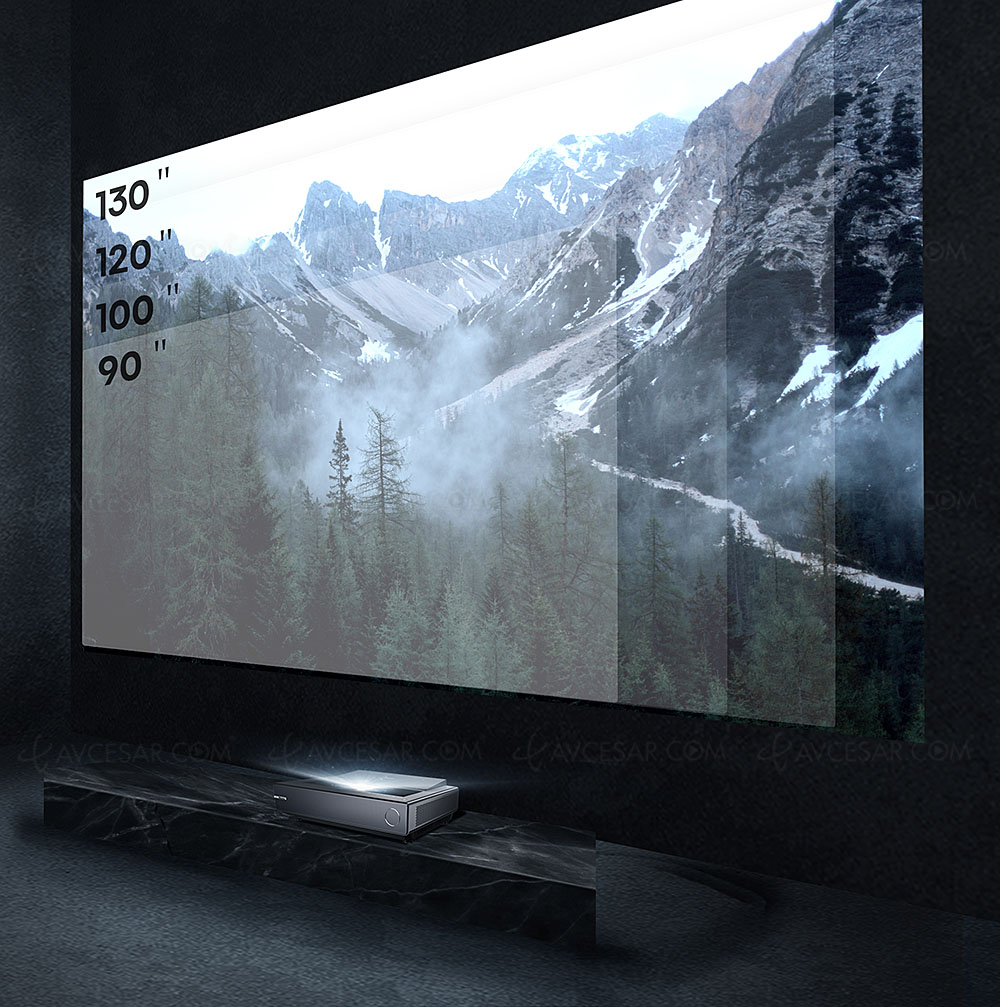
But Hisense quickly chose technological innovation to establish itself as a capable brand. to propose solutions to the futuristic concept. One of the illustrations of this approach resides in its Laser TV offer, taking up the concept of the ultra-short focal length video projector for gigantic images (see photo above). At the same time, to develop its notoriety, Hisense has deployed a sports sponsorship strategy by establishing itself as the historical partner of the last Euros and the Football World Cup.

DTT tuner, sound, short focal length and screen provided In this regard, let's specify how a Laser TV differs from a traditional very short-throw video projector. In fact, the two most striking differences are the presence of a DTT tuner and the provision of a screen, whereas video projectors do not have these features. Indeed, to deserve the addition of the TV label to its name, the equipment must imperatively be able to access television programs exactly as a conventional television would. Thus, during its installation, all you have to do is ask the Laser TV to “scan†all the available TV channels so that they pick them up and store them. In short, when it comes to receiving TNT channels, a Laser TV behaves exactly like a television. In addition, as mentioned, a so-called technical screen is therefore systematically delivered with Laser TVs, which is not the case when purchasing a video projector.
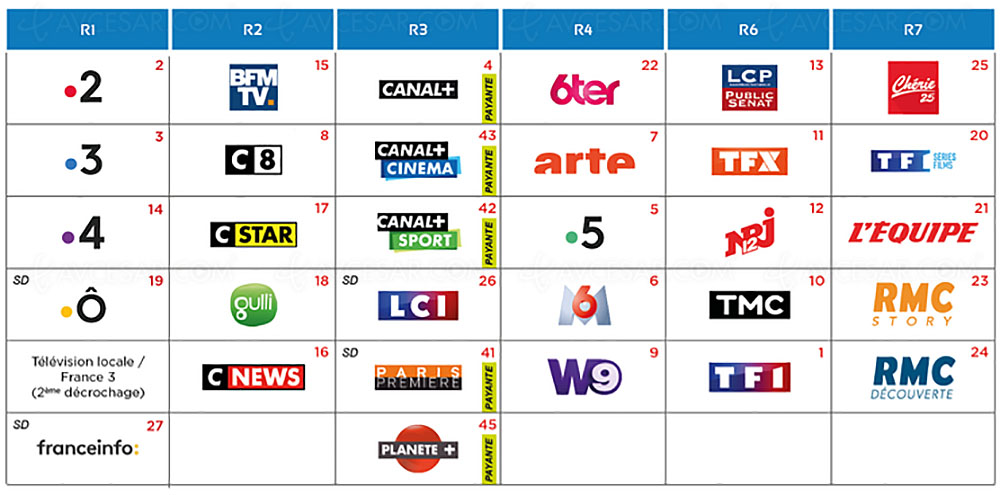
Laser TV, l technical screen is part of the equation Note that this imposed delivery of the technical screen, known as ALR (Ambient Light Rejecting) or CLR (Ceiling Light Rejecting), has a dual purpose. Firstly, it consists of micro-mirrors arranged according to a so-called Fresnel structure. Its surface is entirely covered with microscopic horizontal streaks. Each of them carries a tiny mirror oriented at 45 degrees.
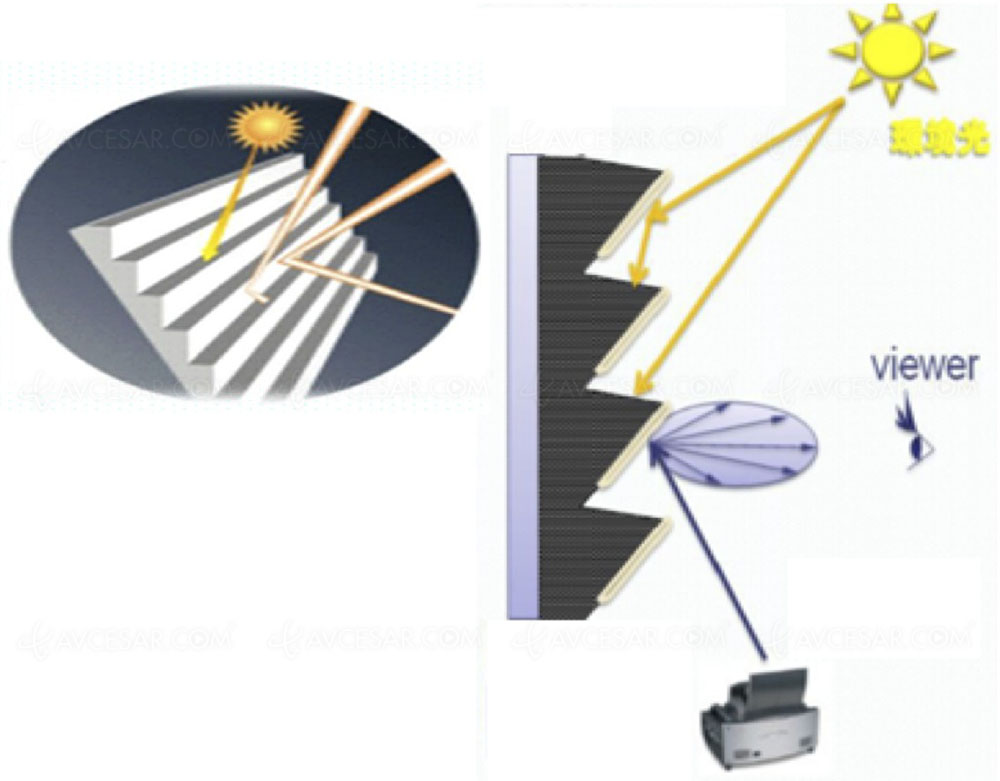
Although invisible during the use of the Laser TV, this structure offers two essential advantages. Above all, it very effectively directs the light from the Laser TV towards the spectators, then it opposes the reflection of parasitic lights, such as windows or lights, on the screen. On its own, the Fresnel structure therefore ensures both the reinforcement of the luminosity of the Laser TV and the role of anti-reflective filter. This results in a considerable gain in terms of luminosity of the perceived image and its contrasts. Thus, unlike a conventional video projector, a Laser TV can be used in a “natural†lighting environment. Like, here again, a traditional television. Absolute black to benefit from a (huge) image, of quality, is no longer an imperative.
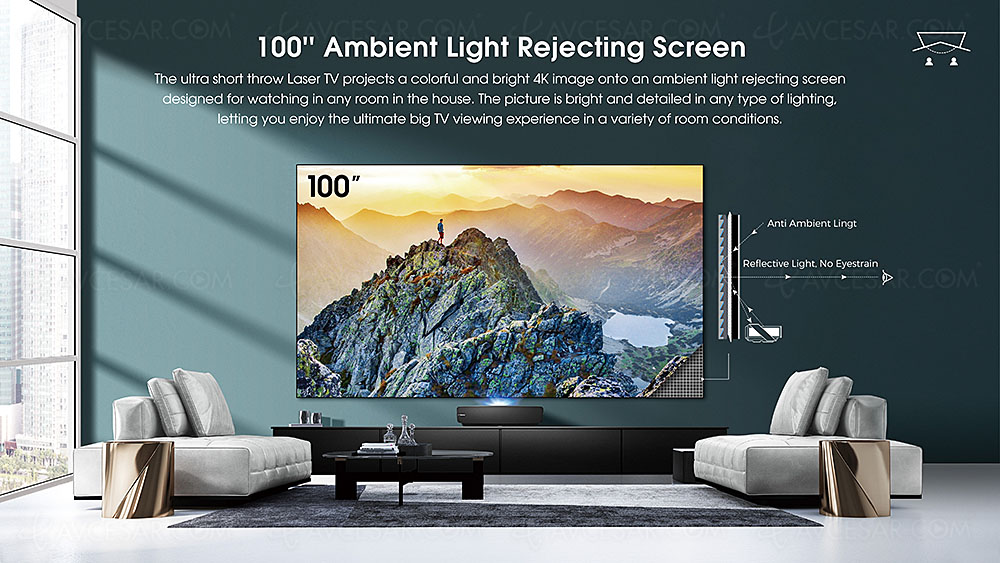
The other advantage provided by the supply of the screen lies in the fact that it is not necessary to use a zoom to adjust the size of the image to that of the screen. On a Laser TV, everything is “predeterminedâ€. Its distance from the screen is fixed, as is the size of the image. However, due to its positioning vis-à -vis the screen, a simple conventional spherical lens is not sufficient to compensate for the aberrations in the geometry of the image associated with this type of arrangement. Let's not forget that the Laser TV is not only extremely close to the screen, but, what's more, under it (see illustration below). A single lens would only deliver an out-of-focus trapezium image across its entire surface. Thus, the optical system of a Laser TV is based on aspherical lenses with a profile skilfully studied and modeled on a computer in order to rectify the geometry of the image and its focusing. If the design of such a lens is complex, its manufacture remains much less delicate than if it were necessary to equip the Laser TV with a zoom. This choice of fixed screen, therefore of fixed focal length, makes it possible to reduce its production cost and therefore its final marketing price compared to that of a short-throw projector equipped with a zoom lens with equivalent characteristics.
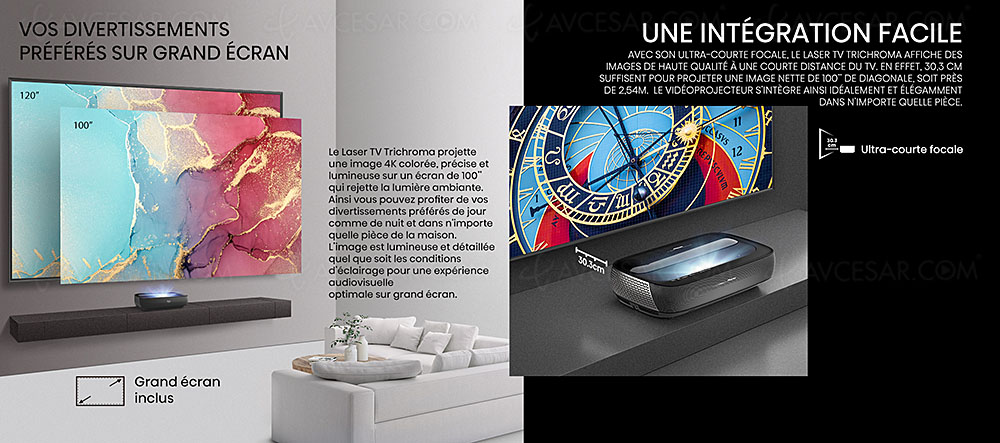
Laser TV, DLP chip and laser source It is nonetheless true that the heart of a Laser TV is identical to that of a video projector. To display the image, the Laser TVs use a DLP Ultra HD 4K chip from Texas Instrument. A solution also used by traditional video projectors. Still based on a checkerboard of mobile micromirrors, this chip therefore has a definition of 3,840 x 2,160 pixels. There are therefore more than 8 million mirrors which are oriented to form the image. The light source, on the other hand, has been completely revised. Instead of the fragile and energy-consuming lamp, a single laser diode capable of delivering the three fundamental colors or three laser diodes are used (see image below). This modification has many advantages. First of all, with better efficiency than lamps, laser diodes heat up much less. A point that allows them to be associated with a simpler and quieter cooling circuit. In addition, the laser solution also simplifies the optical path that light follows to reach the DLP chip. Lamp systems require the presence of a chromatic wheel, rotating at high speed, equipped with red, green and blue sectors, to restore a color image. The latest generation Laser TVs, for their part, use three laser LEDs: one red, one green and one blue. The chromatic wheel can then be eliminated, the color selection being made by electronic switching of each diode. The absence of any mechanical element also simplifies assembly of the device, which again reduces production costs.
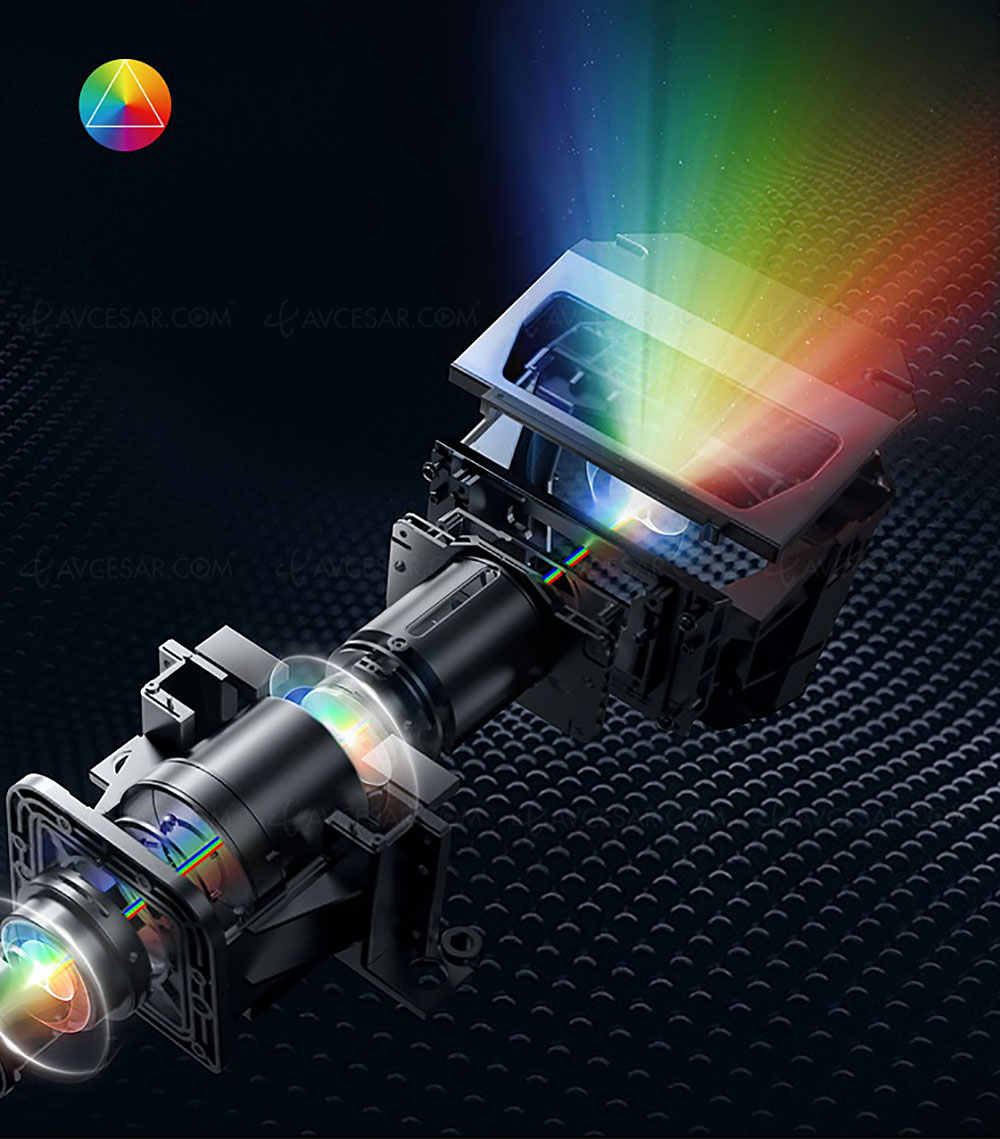
Laser TV, same functionality as on a television! !!! While the functionalities available on a video projector are limited and comparable to those offered by a computer monitor, we find on Laser TVs the same specificities and functionalities as on a television. In addition to traditional connectors allowing the usual interconnections, such as HDMI ports or analog inputs, Laser TVs have the Smart TV function based on the "in-house" Vidaa OS operating system with, for the sixth and final iteration, the built-in Amazon Alexa voice. They then have a Content Hub offering, among other things, direct access to Netflix, Youtube, Prime Video, etc.
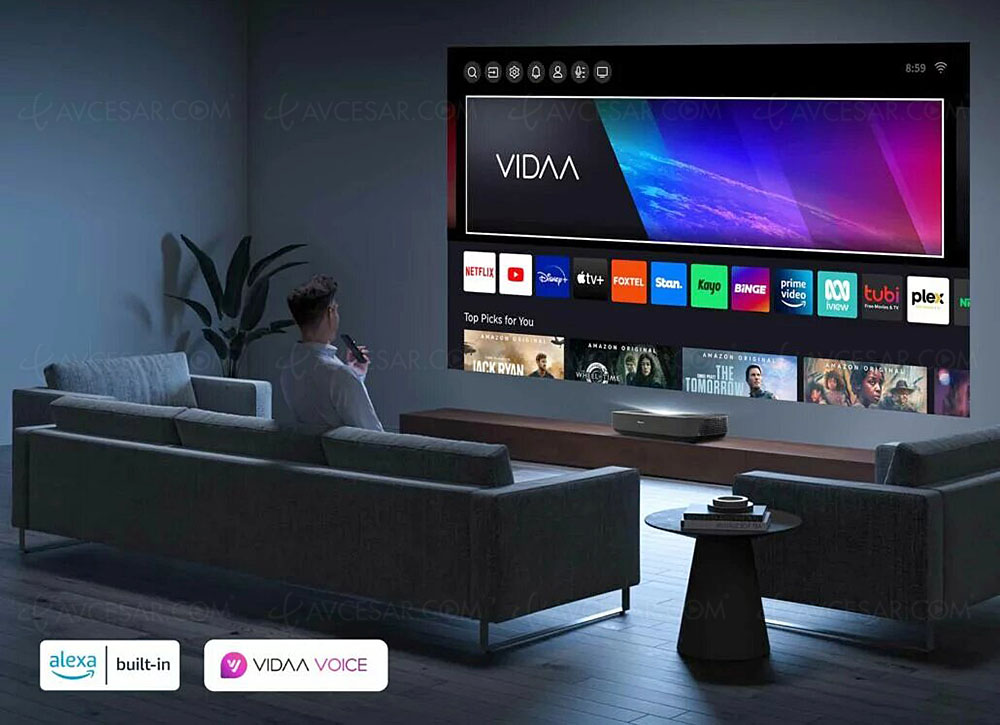
Laser TV, sound is part of the experience!!! ! Finally, it is also almost systematic that the video projectors are equipped only with an “embryonic†sound, or that they are completely devoid of it. Once again, the Laser TVs mark their difference. The elaborate solution proposed by Hisense integrates a real soundbar in all its models. Dolby Atmos compatible, it is ready to recreate the atmosphere of a cinema. In short, a sound rendering in line with the size of the displayed image.
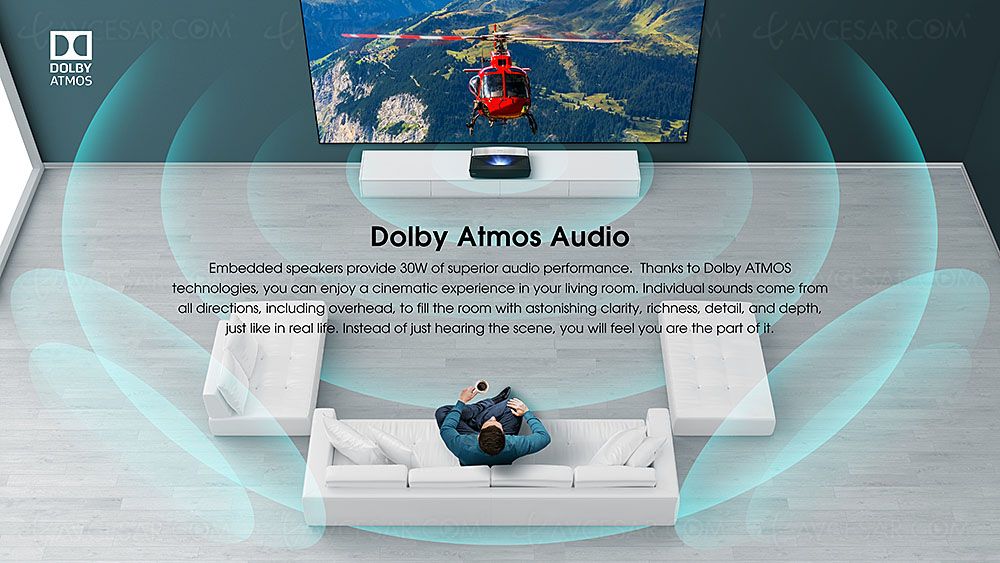
2023, the Hisense Laser TV family is growing In addition, Hisense still has a lot of ideas in its boxes and the brand is enriching its offer, from 2023, with products corresponding to the expectations of new consumers and, in particular, those who are skeptical about video projection. While the L5 series, equipped with a single laser diode, is the brand's entry-level for Laser TVs supplied with a screen, the L9 series, equipped with the Trichroma label indicating the presence of three RGB laser sources, constitutes a parallel sector. for a much better respect of the colors. The novelty lies, with the references Hisense PL1 (on the left in the photo below) and Hisense PX2-Pro (on the right in the photo below), in the new Laser Cinema series so named because equipped with an adjustable focal length and no screen. At the same time, the equipment in the PL1 and PX1 ranges is respectively equipped with the exclusive Vidaa OS and Android so that they can directly access streaming content sources.

Laser Hisense 120LX Ultra HD 8K TV coming soon Namely, Hisense announces, for the near future, the 120LX. This very high-end Laser TV presented at CES in Las Vegas 2023 in early January, is based on an 8K DLP chip designed in close collaboration with Texas Instrument, creator of DLP technology (see our news (UPDATE) CES 23 > Laser Hisense 120LX 8K TV, specifics update).

0 Hisense Laser, go life on the move Finally, Hisense also relies on mobility and nomadism. To meet the expectations generated by these new markets, the brand is offering the Smart Mini-projector with the Cube C1. New equipment halfway between Laser TV and video projector, despite its compactness (254 x 216 x 179 mm), it relies on a very high diagonal image quality of up to 300'' (762 cm). For this, it is equipped with a triple laser light source (Trichroma label) and the Vidaa OS operating system to directly access all kinds of content sources, streaming for example.

1 Hisense, to each his own diffuser… But Hisense does not limit its production to that of Laser TV. While the brand has offered this type of product since 2014 to have a range rich in references by 2023, it also masters all the display technologies existing to date (Laser TV, QLED, Mini LED and Oled). A position that allows it to be the fourth largest television manufacturer worldwide and first for Laser TV. It thus offers the user the possibility of opting for the technology that best suits their expectations in terms of budget, image quality and/or screen size.
 But Hisense quickly chose technological innovation to establish itself as a capable brand. to propose solutions to the futuristic concept. One of the illustrations of this approach resides in its Laser TV offer, taking up the concept of the ultra-short focal length video projector for gigantic images (see photo above). At the same time, to develop its notoriety, Hisense has deployed a sports sponsorship strategy by establishing itself as the historical partner of the last Euros and the Football World Cup.
But Hisense quickly chose technological innovation to establish itself as a capable brand. to propose solutions to the futuristic concept. One of the illustrations of this approach resides in its Laser TV offer, taking up the concept of the ultra-short focal length video projector for gigantic images (see photo above). At the same time, to develop its notoriety, Hisense has deployed a sports sponsorship strategy by establishing itself as the historical partner of the last Euros and the Football World Cup.  DTT tuner, sound, short focal length and screen provided In this regard, let's specify how a Laser TV differs from a traditional very short-throw video projector. In fact, the two most striking differences are the presence of a DTT tuner and the provision of a screen, whereas video projectors do not have these features. Indeed, to deserve the addition of the TV label to its name, the equipment must imperatively be able to access television programs exactly as a conventional television would. Thus, during its installation, all you have to do is ask the Laser TV to “scan†all the available TV channels so that they pick them up and store them. In short, when it comes to receiving TNT channels, a Laser TV behaves exactly like a television. In addition, as mentioned, a so-called technical screen is therefore systematically delivered with Laser TVs, which is not the case when purchasing a video projector.
DTT tuner, sound, short focal length and screen provided In this regard, let's specify how a Laser TV differs from a traditional very short-throw video projector. In fact, the two most striking differences are the presence of a DTT tuner and the provision of a screen, whereas video projectors do not have these features. Indeed, to deserve the addition of the TV label to its name, the equipment must imperatively be able to access television programs exactly as a conventional television would. Thus, during its installation, all you have to do is ask the Laser TV to “scan†all the available TV channels so that they pick them up and store them. In short, when it comes to receiving TNT channels, a Laser TV behaves exactly like a television. In addition, as mentioned, a so-called technical screen is therefore systematically delivered with Laser TVs, which is not the case when purchasing a video projector.  Laser TV, l technical screen is part of the equation Note that this imposed delivery of the technical screen, known as ALR (Ambient Light Rejecting) or CLR (Ceiling Light Rejecting), has a dual purpose. Firstly, it consists of micro-mirrors arranged according to a so-called Fresnel structure. Its surface is entirely covered with microscopic horizontal streaks. Each of them carries a tiny mirror oriented at 45 degrees.
Laser TV, l technical screen is part of the equation Note that this imposed delivery of the technical screen, known as ALR (Ambient Light Rejecting) or CLR (Ceiling Light Rejecting), has a dual purpose. Firstly, it consists of micro-mirrors arranged according to a so-called Fresnel structure. Its surface is entirely covered with microscopic horizontal streaks. Each of them carries a tiny mirror oriented at 45 degrees.  Although invisible during the use of the Laser TV, this structure offers two essential advantages. Above all, it very effectively directs the light from the Laser TV towards the spectators, then it opposes the reflection of parasitic lights, such as windows or lights, on the screen. On its own, the Fresnel structure therefore ensures both the reinforcement of the luminosity of the Laser TV and the role of anti-reflective filter. This results in a considerable gain in terms of luminosity of the perceived image and its contrasts. Thus, unlike a conventional video projector, a Laser TV can be used in a “natural†lighting environment. Like, here again, a traditional television. Absolute black to benefit from a (huge) image, of quality, is no longer an imperative.
Although invisible during the use of the Laser TV, this structure offers two essential advantages. Above all, it very effectively directs the light from the Laser TV towards the spectators, then it opposes the reflection of parasitic lights, such as windows or lights, on the screen. On its own, the Fresnel structure therefore ensures both the reinforcement of the luminosity of the Laser TV and the role of anti-reflective filter. This results in a considerable gain in terms of luminosity of the perceived image and its contrasts. Thus, unlike a conventional video projector, a Laser TV can be used in a “natural†lighting environment. Like, here again, a traditional television. Absolute black to benefit from a (huge) image, of quality, is no longer an imperative.  The other advantage provided by the supply of the screen lies in the fact that it is not necessary to use a zoom to adjust the size of the image to that of the screen. On a Laser TV, everything is “predeterminedâ€. Its distance from the screen is fixed, as is the size of the image. However, due to its positioning vis-à -vis the screen, a simple conventional spherical lens is not sufficient to compensate for the aberrations in the geometry of the image associated with this type of arrangement. Let's not forget that the Laser TV is not only extremely close to the screen, but, what's more, under it (see illustration below). A single lens would only deliver an out-of-focus trapezium image across its entire surface. Thus, the optical system of a Laser TV is based on aspherical lenses with a profile skilfully studied and modeled on a computer in order to rectify the geometry of the image and its focusing. If the design of such a lens is complex, its manufacture remains much less delicate than if it were necessary to equip the Laser TV with a zoom. This choice of fixed screen, therefore of fixed focal length, makes it possible to reduce its production cost and therefore its final marketing price compared to that of a short-throw projector equipped with a zoom lens with equivalent characteristics.
The other advantage provided by the supply of the screen lies in the fact that it is not necessary to use a zoom to adjust the size of the image to that of the screen. On a Laser TV, everything is “predeterminedâ€. Its distance from the screen is fixed, as is the size of the image. However, due to its positioning vis-à -vis the screen, a simple conventional spherical lens is not sufficient to compensate for the aberrations in the geometry of the image associated with this type of arrangement. Let's not forget that the Laser TV is not only extremely close to the screen, but, what's more, under it (see illustration below). A single lens would only deliver an out-of-focus trapezium image across its entire surface. Thus, the optical system of a Laser TV is based on aspherical lenses with a profile skilfully studied and modeled on a computer in order to rectify the geometry of the image and its focusing. If the design of such a lens is complex, its manufacture remains much less delicate than if it were necessary to equip the Laser TV with a zoom. This choice of fixed screen, therefore of fixed focal length, makes it possible to reduce its production cost and therefore its final marketing price compared to that of a short-throw projector equipped with a zoom lens with equivalent characteristics.  Laser TV, DLP chip and laser source It is nonetheless true that the heart of a Laser TV is identical to that of a video projector. To display the image, the Laser TVs use a DLP Ultra HD 4K chip from Texas Instrument. A solution also used by traditional video projectors. Still based on a checkerboard of mobile micromirrors, this chip therefore has a definition of 3,840 x 2,160 pixels. There are therefore more than 8 million mirrors which are oriented to form the image. The light source, on the other hand, has been completely revised. Instead of the fragile and energy-consuming lamp, a single laser diode capable of delivering the three fundamental colors or three laser diodes are used (see image below). This modification has many advantages. First of all, with better efficiency than lamps, laser diodes heat up much less. A point that allows them to be associated with a simpler and quieter cooling circuit. In addition, the laser solution also simplifies the optical path that light follows to reach the DLP chip. Lamp systems require the presence of a chromatic wheel, rotating at high speed, equipped with red, green and blue sectors, to restore a color image. The latest generation Laser TVs, for their part, use three laser LEDs: one red, one green and one blue. The chromatic wheel can then be eliminated, the color selection being made by electronic switching of each diode. The absence of any mechanical element also simplifies assembly of the device, which again reduces production costs.
Laser TV, DLP chip and laser source It is nonetheless true that the heart of a Laser TV is identical to that of a video projector. To display the image, the Laser TVs use a DLP Ultra HD 4K chip from Texas Instrument. A solution also used by traditional video projectors. Still based on a checkerboard of mobile micromirrors, this chip therefore has a definition of 3,840 x 2,160 pixels. There are therefore more than 8 million mirrors which are oriented to form the image. The light source, on the other hand, has been completely revised. Instead of the fragile and energy-consuming lamp, a single laser diode capable of delivering the three fundamental colors or three laser diodes are used (see image below). This modification has many advantages. First of all, with better efficiency than lamps, laser diodes heat up much less. A point that allows them to be associated with a simpler and quieter cooling circuit. In addition, the laser solution also simplifies the optical path that light follows to reach the DLP chip. Lamp systems require the presence of a chromatic wheel, rotating at high speed, equipped with red, green and blue sectors, to restore a color image. The latest generation Laser TVs, for their part, use three laser LEDs: one red, one green and one blue. The chromatic wheel can then be eliminated, the color selection being made by electronic switching of each diode. The absence of any mechanical element also simplifies assembly of the device, which again reduces production costs.  Laser TV, same functionality as on a television! !!! While the functionalities available on a video projector are limited and comparable to those offered by a computer monitor, we find on Laser TVs the same specificities and functionalities as on a television. In addition to traditional connectors allowing the usual interconnections, such as HDMI ports or analog inputs, Laser TVs have the Smart TV function based on the "in-house" Vidaa OS operating system with, for the sixth and final iteration, the built-in Amazon Alexa voice. They then have a Content Hub offering, among other things, direct access to Netflix, Youtube, Prime Video, etc.
Laser TV, same functionality as on a television! !!! While the functionalities available on a video projector are limited and comparable to those offered by a computer monitor, we find on Laser TVs the same specificities and functionalities as on a television. In addition to traditional connectors allowing the usual interconnections, such as HDMI ports or analog inputs, Laser TVs have the Smart TV function based on the "in-house" Vidaa OS operating system with, for the sixth and final iteration, the built-in Amazon Alexa voice. They then have a Content Hub offering, among other things, direct access to Netflix, Youtube, Prime Video, etc.  Laser TV, sound is part of the experience!!! ! Finally, it is also almost systematic that the video projectors are equipped only with an “embryonic†sound, or that they are completely devoid of it. Once again, the Laser TVs mark their difference. The elaborate solution proposed by Hisense integrates a real soundbar in all its models. Dolby Atmos compatible, it is ready to recreate the atmosphere of a cinema. In short, a sound rendering in line with the size of the displayed image.
Laser TV, sound is part of the experience!!! ! Finally, it is also almost systematic that the video projectors are equipped only with an “embryonic†sound, or that they are completely devoid of it. Once again, the Laser TVs mark their difference. The elaborate solution proposed by Hisense integrates a real soundbar in all its models. Dolby Atmos compatible, it is ready to recreate the atmosphere of a cinema. In short, a sound rendering in line with the size of the displayed image.  2023, the Hisense Laser TV family is growing In addition, Hisense still has a lot of ideas in its boxes and the brand is enriching its offer, from 2023, with products corresponding to the expectations of new consumers and, in particular, those who are skeptical about video projection. While the L5 series, equipped with a single laser diode, is the brand's entry-level for Laser TVs supplied with a screen, the L9 series, equipped with the Trichroma label indicating the presence of three RGB laser sources, constitutes a parallel sector. for a much better respect of the colors. The novelty lies, with the references Hisense PL1 (on the left in the photo below) and Hisense PX2-Pro (on the right in the photo below), in the new Laser Cinema series so named because equipped with an adjustable focal length and no screen. At the same time, the equipment in the PL1 and PX1 ranges is respectively equipped with the exclusive Vidaa OS and Android so that they can directly access streaming content sources.
2023, the Hisense Laser TV family is growing In addition, Hisense still has a lot of ideas in its boxes and the brand is enriching its offer, from 2023, with products corresponding to the expectations of new consumers and, in particular, those who are skeptical about video projection. While the L5 series, equipped with a single laser diode, is the brand's entry-level for Laser TVs supplied with a screen, the L9 series, equipped with the Trichroma label indicating the presence of three RGB laser sources, constitutes a parallel sector. for a much better respect of the colors. The novelty lies, with the references Hisense PL1 (on the left in the photo below) and Hisense PX2-Pro (on the right in the photo below), in the new Laser Cinema series so named because equipped with an adjustable focal length and no screen. At the same time, the equipment in the PL1 and PX1 ranges is respectively equipped with the exclusive Vidaa OS and Android so that they can directly access streaming content sources.  Laser Hisense 120LX Ultra HD 8K TV coming soon Namely, Hisense announces, for the near future, the 120LX. This very high-end Laser TV presented at CES in Las Vegas 2023 in early January, is based on an 8K DLP chip designed in close collaboration with Texas Instrument, creator of DLP technology (see our news (UPDATE) CES 23 > Laser Hisense 120LX 8K TV, specifics update).
Laser Hisense 120LX Ultra HD 8K TV coming soon Namely, Hisense announces, for the near future, the 120LX. This very high-end Laser TV presented at CES in Las Vegas 2023 in early January, is based on an 8K DLP chip designed in close collaboration with Texas Instrument, creator of DLP technology (see our news (UPDATE) CES 23 > Laser Hisense 120LX 8K TV, specifics update).  0 Hisense Laser, go life on the move Finally, Hisense also relies on mobility and nomadism. To meet the expectations generated by these new markets, the brand is offering the Smart Mini-projector with the Cube C1. New equipment halfway between Laser TV and video projector, despite its compactness (254 x 216 x 179 mm), it relies on a very high diagonal image quality of up to 300'' (762 cm). For this, it is equipped with a triple laser light source (Trichroma label) and the Vidaa OS operating system to directly access all kinds of content sources, streaming for example.
0 Hisense Laser, go life on the move Finally, Hisense also relies on mobility and nomadism. To meet the expectations generated by these new markets, the brand is offering the Smart Mini-projector with the Cube C1. New equipment halfway between Laser TV and video projector, despite its compactness (254 x 216 x 179 mm), it relies on a very high diagonal image quality of up to 300'' (762 cm). For this, it is equipped with a triple laser light source (Trichroma label) and the Vidaa OS operating system to directly access all kinds of content sources, streaming for example.  1 Hisense, to each his own diffuser… But Hisense does not limit its production to that of Laser TV. While the brand has offered this type of product since 2014 to have a range rich in references by 2023, it also masters all the display technologies existing to date (Laser TV, QLED, Mini LED and Oled). A position that allows it to be the fourth largest television manufacturer worldwide and first for Laser TV. It thus offers the user the possibility of opting for the technology that best suits their expectations in terms of budget, image quality and/or screen size.
1 Hisense, to each his own diffuser… But Hisense does not limit its production to that of Laser TV. While the brand has offered this type of product since 2014 to have a range rich in references by 2023, it also masters all the display technologies existing to date (Laser TV, QLED, Mini LED and Oled). A position that allows it to be the fourth largest television manufacturer worldwide and first for Laser TV. It thus offers the user the possibility of opting for the technology that best suits their expectations in terms of budget, image quality and/or screen size. 